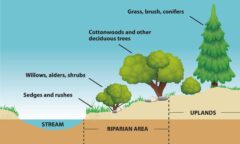Following the posting of our newsletter article on this topic last month SWOA received several questions from members asking for additional information. As the answers could be of general interest to our members it was decided to draft a follow-up article on the topic.
As noted in the October newsletter, the Riparian Areas Protection Regulation (RAPR) dictates how far back (setbacks) from the high-water mark development can take place on waterfront properties. When you look at the regulation you will find that the setbacks are defined in terms related to a “stream”. But aren’t we talking about a lake here? We are but to find some clarity you have to refer to the BC Water Sustainability Act definitions which define a “stream” to include:
“(a) a natural watercourse, including a natural glacier course, or a natural body of water, whether or not the stream channel of the stream has been modified, or
(b) a natural source of water supply,
including, without limitation, a lake, pond, river, creek, spring, ravine, gulch, wetland or glacier, whether or not usually containing water, including ice, but does not include an aquifer; (Bolder text for emphasis)”
So you can see that the use of the word “stream” in the context of the RAPR is being interpreted broadly.
The RAP Regulation (RAPR) is applied Province wide and therefore has been drafted to cover conditions that might be found along “streams” generally. In many areas the concern that is being dealt with relates to the mitigating effect that stream side vegetation can have on the thermal conditions in the stream and the maintenance of fish habitat. However in the context of a large lake, like the Shuswap, shading by trees along the shoreline will have very limited effect on the overall thermal balance in the lake. Therefore, the agencies have provided guidance in relation to the aspect of the property - does the property face, north, south, east or west? - and there is no longer any flexibility with respect to setbacks. If your property faces north, the setback is 30 m. If you face south, west, or east the setback is 15 m.
We have been asked how the RAPR would apply to property that might be situated on a point or in a bay that would have differing waterfront aspects? Generally, the dominant aspect of each section of the waterfront will dictate the setback. So if part of the property faces northeast, a trigonometric calculation would be made to determine how large the setback should be along this part of the shore. It is conceivable that part of the property on an east facing point could have a setback of 30 meters for the north side of the property, perhaps 22 meters for the northeast facing waterfront, and 15 meters for the parts facing south, south east, or east.
This illustration has been provided just to indicate that for many situations the property owner should seek expert help in assessing the expected setbacks before building on their waterfront property.


What do these set backs mean for existing cottages that do not meet the 15m or 30 m setbacks regulations? Are they “grandfathered”? If they need rebuilding and the lot can’t accommodate a 15 or 30 m setback, is the owner just out of luck?
Mike; Thanks for your questions. Existing cottages are grandfathered. However, a waterfront owner can no longer rebuild on an existing foundation within the setback area. If more than 75% of the value above the foundation is destroyed (by accident or willfully), then the setback must be followed.
2.1 A building within the setback area can be maintained but there must not be any structural modifications or expansion
2.2 If you have land across the road that you can build on, then you will be forced to build there
2.3 If you have no options to rebuild except within a setback area, then there is a hardship process that will likely leave you with a smaller house than what you want.
The Area C and F Official Community Plans were properly introduced through Section 14, introduced the RAR, and met the province’s requirements (at that time?). The CSRD has not introduced the new RAPR legislation yet through Part 14 so until this happens, they are effectively expropriating land and are subject to court action.
What is missing in the RAPR is any sense of fairness. Waterfront owners may find their “nest egg” reduced to where there is no value.